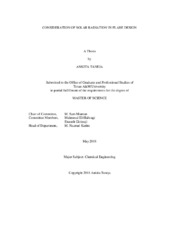| dc.description.abstract | At oil refineries and other chemical processing plants, a flare stack is used to get rid of unwanted or excessive gases and relieve the system of excess pressure. These gases can be generated during different stages of operation like startup or shutdown, maintenance and process upsets. Since flares handle large amounts of toxic and flammable materials, it makes the flaring operation hazardous. Combustion of huge amount of gases releases heat which is radiated to the atmosphere. Heat radiated from the flare makes it important for siting the flare at a proper location. The heat radiation should not exceed recommended threshold levels so that people on-site and the equipment are not affected. Thus, to have a well-designed flare, knowledge of total radiation emitted from a flare is essential. It will aid in accurately estimating the flare height and the area near the flare, which would sustain high levels of thermal radiation.
A common point of contention while calculating radiation level emitted from flare is the decision of including solar radiation (SR) in the calculations. API 521 relegates this decision to the flare design company’s practices. Based on expert judgement, some literature states that for all practical purposes, solar radiation contribution can be discounted.
The work performed aims at presenting a framework which quantitatively addresses aforementioned obscurity. The analysis helps flare designers to more objectively decide whether to include SR in their analyses or treat it insignificant contribution. The work studies the various factors that cause variation in SR value: location, time, and orientation of the surface. Considering all these parameters, an appropriate value of SR is chosen as the solar contribution to the thermal radiation from the flare. The effect of SR to the design of the flare is quantified by studying the change in effect distance near the flare and the height of the flare. Consequence analysis software PHAST is used to obtain these calculations. In addition, the outcome that SR inclusion will have on the risk posed by the flare due to thermal radiation on personnel is also examined. This is studied by measuring the change in lethality and heat stress caused by radiation exposure. | en |


